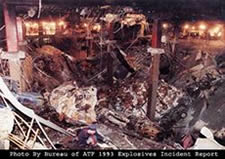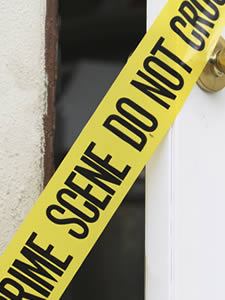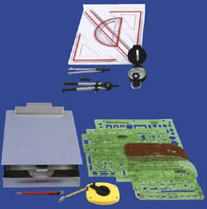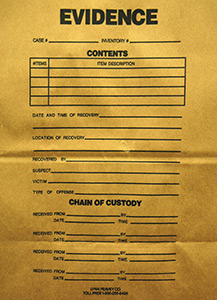Home | Glossary | Resources | Help | Contact Us | Course Map
Archival Notice
This is an archive page that is no longer being updated. It may contain outdated information and links may no longer function as originally intended.
The Crime Scene
No two crime scenes are the same. The nature of the crime and agency protocols determine how the scene is processed.
Safety
The first priority on arrival at a crime scene is to protect life. There are many circumstances in which safety is an issue at a crime scene. Examples include booby traps, risk of fire or explosion from unsafe apparatus at clandestine drug laboratories, exposure to biological hazards (e.g., blood-stained clothing and discarded needles from drug users), and physical and environmental hazards, including weather.
| Example: |
| A good example of physical hazards is the scene that confronted investigators at the World Trade Center bombing in February 1993. The bomb destroyed several floors of the parking garage. The first investigators were working in a highly unsafe environment due to a major power outage and water that froze after the fire was extinguished. |
Protecting the Scene
The crime scene must be protected to minimize the risk of contamination and loss of evidence. For example, coughing or sneezing may introduce contaminating DNA into biological samples. Footprints left by a perpetrator may be inadvertently destroyed by a nonessential observer.
Access to a scene should be limited to those with a need to be present. An officer with the power to control access must be placed in charge of the scene. The perimeter must be secured, and a log must be kept of persons allowed entry.
Some scenes require the participation of specialist personnel, such as a medical examiner or crime laboratory analyst. Such personnel should be aware of the basic principles of crime scene investigation. The officer in charge of the scene should make certain that specialist personnel adhere to processing protocol and maintain the integrity of the crime scene.
Crime laboratory analysts called to assist at a crime scene should adhere to laboratory policies in documenting their search and collecting evidence.
Appropriate personal protection equipment must be worn for the safety of the wearer and to prevent contamination of the scene.
Recording the Scene
The crime scene may be documented using the following:
- Notes
- Written
- Audio
- Sketches and/or diagrams
- Photography
- Still
- Video
Records should document activities taking place during the examination and processing of the scene. The area in which the crime occurred as well as the surrounding area should be identified and documented.
Chain of Custody
The chain of custody for all items collected from the scene must include
- unique identifier,
- item description,
- identity of the person who collected the item,
- time and date of collection,
- location where item was found.
Location of Evidence
Some scenes require more protection than others. An indoor scene will usually have good lighting and be protected from environmental degradation. In contrast, an outdoor scene may require supplemental lighting and/or the construction of shelters over key areas.
The crime scene must be examined in a planned and systematic fashion.
Common approaches include these:
- Spiral examination originating and working outward from a central point
- Parallel examination of a corridor from one boundary to the next, then turning and examining the adjacent lane
- Grid examination of the scene using the parallel method, then performing a second parallel search at 90 to the first.
- Zones examination of the scene in quadrants or large areas
Items of evidential value may be identified by the following:
- Naked eye tire tracks or discarded weapons
- Search equipment alternate light source (ALS) or screening tests for body fluids
- Laboratory testing trace evidence
Additional Online Courses
- What Every First Responding Officer Should Know About DNA Evidence
- Collecting DNA Evidence at Property Crime Scenes
- DNA – A Prosecutor’s Practice Notebook
- Crime Scene and DNA Basics
- Laboratory Safety Programs
- DNA Amplification
- Population Genetics and Statistics
- Non-STR DNA Markers: SNPs, Y-STRs, LCN and mtDNA
- Firearms Examiner Training
- Forensic DNA Education for Law Enforcement Decisionmakers
- What Every Investigator and Evidence Technician Should Know About DNA Evidence
- Principles of Forensic DNA for Officers of the Court
- Law 101: Legal Guide for the Forensic Expert
- Laboratory Orientation and Testing of Body Fluids and Tissues
- DNA Extraction and Quantitation
- STR Data Analysis and Interpretation
- Communication Skills, Report Writing, and Courtroom Testimony
- Español for Law Enforcement
- Amplified DNA Product Separation for Forensic Analysts





